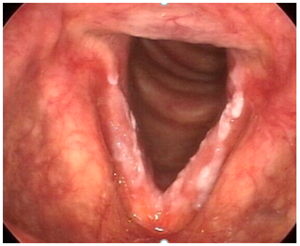 Vocal fold leukoplakia is a white patch-like lesion that forms on the surface of one or both vocal folds. The lesion has a white appearance due to an increased growth of cells. Abnormal cell growth is called dysplasia, which can be indicative of an early cancerous process.
Vocal fold leukoplakia is a white patch-like lesion that forms on the surface of one or both vocal folds. The lesion has a white appearance due to an increased growth of cells. Abnormal cell growth is called dysplasia, which can be indicative of an early cancerous process.
Vocal Fold Leukoplakia and Dysplasia Risk Factors
Risk factors include exposure to chronic irritation such as cigarette smoking, alcohol abuse, environmental exposure to irritants, or laryngopharyngeal reflux (LPR).
Symptoms of Vocal Fold Leukoplakia and Dysplasia
Symptoms may include hoarseness/raspiness, rough voice quality, vocal strain, and/or vocal fatigue. Severity of symptoms vary based upon the size and location of the lesion(s).
Vocal Fold Leukoplakia and Dysplasia Diagnosis
Our voice care team at the Voice and Swallowing Center has the advanced training and skills necessary to diagnose this voice condition. During the initial visit, you will be assessed by one of our laryngologists and in some cases, an additional session with one of our voice pathologists. We use cutting-edge diagnostic tests to determine the cause of your voice disorder and to develop your plan of care. Following a thorough discussion of your symptoms and medical history, be expected to undergo the following assessments:
Video Laryngostroboscopy: Using a small camera inserted through the nose or mouth, our specialists are able to assess the health and function of your larynx (voice box) and determine the presence of any vocal fold growths or abnormalities characteristic of vocal fold leukoplakia.
Vocal fold dysplasia can only be diagnosed with a biopsy, which involves removing a small piece of the abnormal tissue and having it tested.
Non-Surgical Treatment of Vocal Fold Leukoplakia and Dysplasia
Depending on the severity of the patient’s symptoms and severity of the dysplasia (if present), treatment options will vary. In many cases of vocal fold leukoplakia, close observation only is an appropriate treatment option. If a long-standing history of smoking is suspected as the cause of voice disorder, it is critical for patients to stop smoking to help prevent the condition from worsening over time.
If laryngopharyngeal reflux (LPR) is a suspected contributor to the vocal fold leukoplakia or dysplasia, LPR is often managed with dietary and lifestyle modifications and/or prescription medications. In some cases, voice therapy with special attention to efficient and healthy voice use may help to reduce some symptoms including vocal effort/fatigue. However, voice therapy techniques will not eliminate the vocal fold lesions.
Surgical Treatment for Vocal Fold Leukoplakia and Dysplasia
If the vocal fold leukoplakia causes symptoms that affect the patient’s ability to communicate, surgical removal including laryngeal microsurgery or laser treatment may be recommended. Surgical treatment is usually the method of choice for patients with dysplasia.
